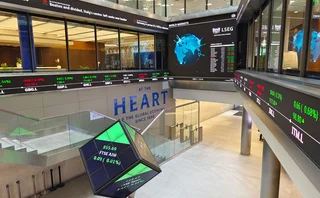
Fintech start-up of the year: Baton Systems
Risk Awards 2020: With four million FX trades since launch, the “institutional PayPal” now aims to free trapped margin

One of the problems facing many new fintech firms is how to summarise their mission – often something specific and complex – in a short, easy-to-understand sentence.
It’s not a problem for Baton Systems. Not any more, at least.
“Baton is like PayPal for large institutions,” says Scott Feldman, a New York-based senior director of business development with CME-owned Traiana.
It’s a simplification of what the firm does, of course, but it neatly encapsulates Baton’s proposition: a layer of connectivity that allows money to be swiftly moved from one participant to another, settling in a matter of minutes rather than hours or days, without either side having to change their existing systems.
What the PayPal comparison misses is the huge risk management benefits on offer. According to figures from US-based industry group, The Clearing House, settling trades costs capital markets participants globally up to $100 billion a year. Much of that figure comes from the operational cost incurred in navigating a complex and inefficient system, or from the lag between execution and settlement of a transaction, when capital and liquidity is tied up.
In foreign exchange, the CLS system exists to manage the risk arising from these lags – taking a payment from one party, a payment from another party, and then releasing them simultaneously – but it operates on a batch system. Baton works on the same payment-versus-payment basis, but by plugging into each party’s systems and synchronising their payments to an escrow account Baton controls, it is able to track and complete the trades in something closer to real time.
The architect of Baton’s solution is chief executive Arjun Jayaram. A serial technologist, he previously worked with Silicon Valley heavyweights such as Twitter and Yahoo, before spying an opportunity in payments and settlements.
“Settlement causes a lot of problems, in both the cleared and over-the-counter sectors. Throughout the cycle there is substantial settlement risk, as well as a high degree of operational inefficiency. And there was nothing that was truly addressing these problems at their very core; that is why we started Baton Systems,” he says.
Since going live at the end of the first quarter in 2018, banks have used Baton’s solution to settle more than four million forex transactions, worth over $2 trillion across internal balance sheets. Baton already settles more than 20 currencies – with others to come – and with banks such as HSBC and JP Morgan already trading on its platform, the market appears to agree it works.
Baton is like PayPal for large institutions
Scott Feldman, Traiana
Baton looked at a number of solutions to the settlement problem. Blockchain was dismissed due to its requirements for a critical mass of participants, and the need to convert funds into digital or cryptocurrencies. But Baton did embrace the principle.
“Currencies and securities are already digital. There are very few actual physical securities anywhere,” says Jayaram. “The problem has not been the digitisation of assets, instead it’s been moving these digital assets across different ledgers because of a lack of visibility. Our way to solve this problem was by directly interfacing with the ledgers of the bank and synchronising these asset movements. That is the heart of what Baton does.”
Building that translation layer between existing ledgers enables real assets to be moved in (almost) real time and circumvents interoperability issues. Both sides of the trade are debited into an escrow account, enabling Baton to get a real-time view of asset movements. From that account, the cash or securities are routed on to their final destination.
“Once [the trade] is confirmed, we legally change the ownership of the assets and then credit both parties. We truly do payment-versus-payment or delivery-versus-payment. And this entire process happens in under three minutes,” Jayaram says.
The potential application of the service extends beyond payments, into clearing and collateral, where Baton is already working with CME, Eurex and LCH. The firm claims to be in discussions with an additional seven clearing houses across Asia, Europe and the US. Here, directly interfacing with participants’ existing ledgers enables the tech outfit to go beyond synchronised payments and into the optimal use of liquidity.
For example, the firm could aggregate data across multiple central counterparties in real time, giving clients a single interface to manage their postings. Applying pre-agreed rules, Baton can then facilitate the pledge, recall and substitution of collateral across those CCPs – in theory ensuring the collateral is used efficiently, rather than operating with trapped pools of excess assets at each clearing house.
Wider network
In November, Baton announced it had built exactly this capability for JP Morgan. Looking ahead, the big question is whether the service could create a network of connected CCPs and member firms, potentially unlocking far greater collateral optimisation benefits.
Jayaram is confident Baton will have signed arrangements with a total of 10 CCPs globally in the near future, and a source from one clearing house backs the technology.
“From both a clearing house and member perspective, what I’ve seen with Baton’s technology is a low-impact way of integrating into the transaction chain, and providing immediate efficiencies for the institutions without being disruptive or requiring re-engineering of their systems,” the source says.
And according to Traiana’s Feldman, while Baton’s technology is cutting edge, it’s the firm’s ease of use that sets it apart. But if the system is straightforward, what stops a competitor offering something similar? Jayaram says solving technological issues was just one part of a puzzle that took about 100 person-years to complete.
“In addition to the technology development, there was a lot of legal work to deal with the issue of achieving settlement finality which complies with electronic fund transfer regulations in the respective jurisdictions. That is what makes it extremely complex. Nobody else has cracked settlement using commercial bank money,” he says.
Only users who have a paid subscription or are part of a corporate subscription are able to print or copy content.
To access these options, along with all other subscription benefits, please contact info@risk.net or view our subscription options here: http://subscriptions.risk.net/subscribe
You are currently unable to print this content. Please contact info@risk.net to find out more.
You are currently unable to copy this content. Please contact info@risk.net to find out more.
Copyright Infopro Digital Limited. All rights reserved.
As outlined in our terms and conditions, https://www.infopro-digital.com/terms-and-conditions/subscriptions/ (point 2.4), printing is limited to a single copy.
If you would like to purchase additional rights please email info@risk.net
Copyright Infopro Digital Limited. All rights reserved.
You may share this content using our article tools. As outlined in our terms and conditions, https://www.infopro-digital.com/terms-and-conditions/subscriptions/ (clause 2.4), an Authorised User may only make one copy of the materials for their own personal use. You must also comply with the restrictions in clause 2.5.
If you would like to purchase additional rights please email info@risk.net
More on Awards
Clearing house of the year: LCH
Risk Awards 2025: LCH outshines rivals in its commitment to innovation and co-operation with clearing members
Best use of machine learning/AI: CompatibL
CompatibL’s groundbreaking use of LLMs for automated trade entry earned the Best use of machine learning/AI award at the 2025 Risk Markets Technology Awards, redefining speed and reliability in what-if analytics
Markets Technology Awards 2025 winners’ review
Vendors jockeying for position in this year’s MTAs, as banks and regulators take aim at counterparty blind spots
Equity derivatives house of the year: Bank of America
Risk Awards 2025: Bank gains plaudits – and profits – with enhanced product range, including new variants of short-vol structures and equity dispersion
Law firm of the year: Linklaters
Risk Awards 2025: Law firm’s work helped buttress markets for credit derivatives, clearing and digital assets
Derivatives house of the year: UBS
Risk Awards 2025: Mega-merger expected to add $1 billion to markets revenues, via 30 integration projects
Interest rate derivatives house of the year: JP Morgan
Risk Awards 2025: Steepener hedges and Spire novations helped clients navigate shifting rates regime
Currency derivatives house of the year: UBS
Risk Awards 2025: Access to wealth management client base helped Swiss bank to recycle volatility and provide accurate pricing for a range of FX structures







